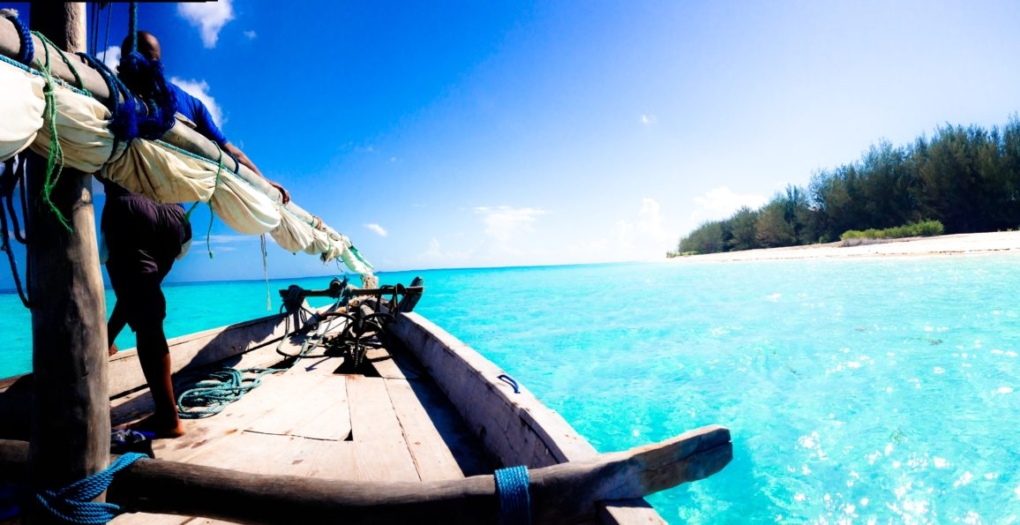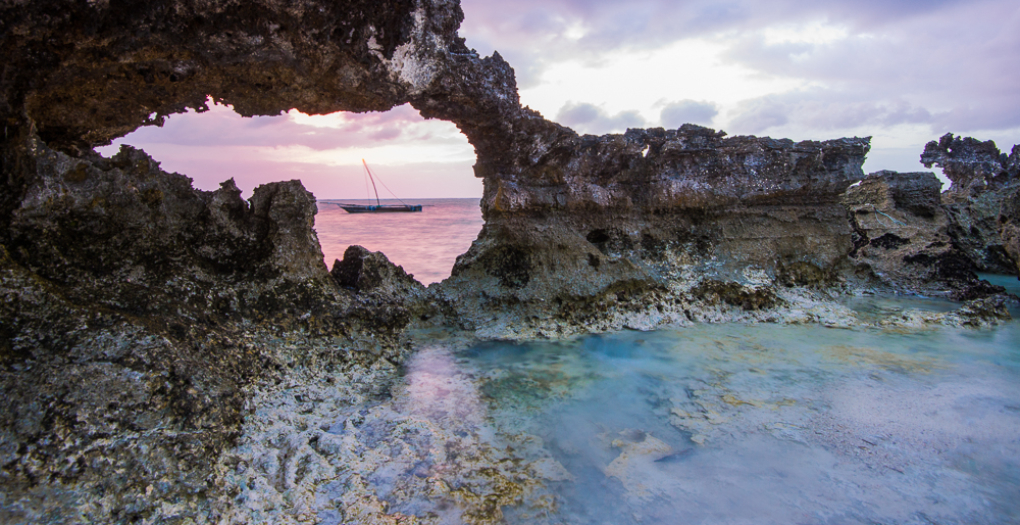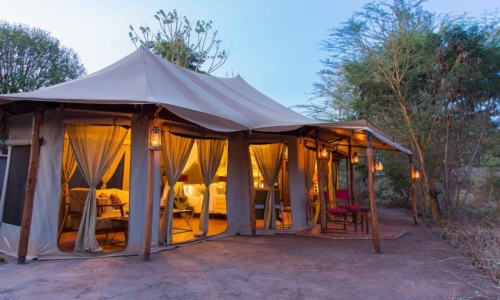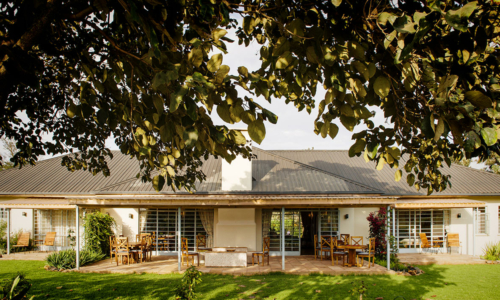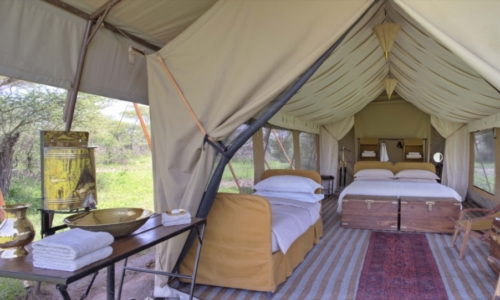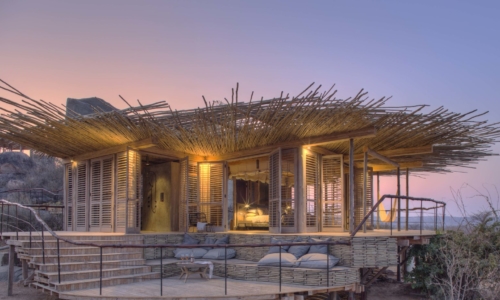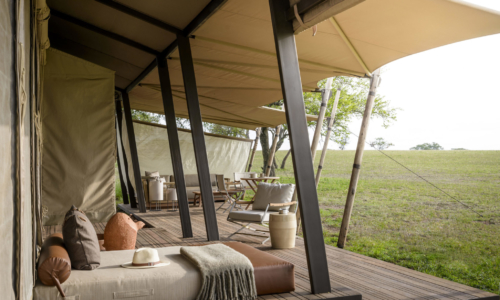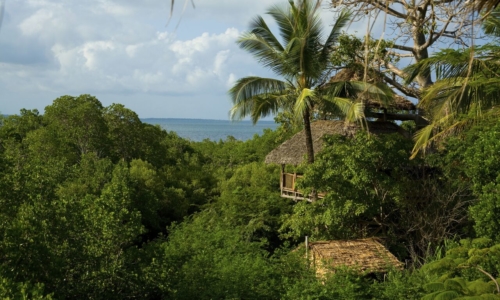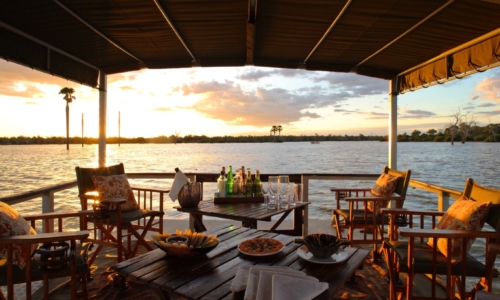The word zanzibar is from the Arabic and Persian languages and means the “Coast of Blacks.” Once the world’s largest producer of cloves, this spice island also provided nutmeg, cardamon, and cinnamon to Europe, the Middle East, and China for over 500 years. Originally founded by Africans, the island was discovered by the Persians in the 10th century. Since then it has had a strong Arabic influence with a brief period where the Portuguese conquered the seaports, only to revert back to Arabic control. The sultan of Oman relocated his capital here.
Zanzibar joined Tanganyika in April 1964 to form a new republic that was renamed Tanzania in October 1964. The region’s capital, located on the island of Unguja, is Zanzibar City, and its historic center, known as Stone Town, is a World Heritage Site.
Zanzibar is an archipelago with two main islands: Unguja and Pemba. The main island of Unguja, is home to the Zanzibar red colobus monkey. And Jozani forest is rumored to have leopards. The lush forests are also inhabited by monkeys, bush-pigs, small antelopes, and civets. Plus, various species of mongoose can also be found on the islands.
Pemba Island is separated from Unguja Island and the African continent by deep channels and has a more restricted fauna, reflecting its relative isolation from the mainland. Most notably, this island is home to the Pemba Flying Fox.
Many of the animals living hereabouts are found deep beneath the turquoise waters in the coral reefs of the warm Indian Ocean. The marine parks provide a sanctuary for moray eels, scorpion fish, lion fish, large groupers, octopuses, lobsters, rays, manta rays, whale sharks, sea turtles, various dolphins, sperm whales and humpback whales. Plus, there are 117 bird species living on the islands, four of whom are globally threatened.
An island paradise with white sandy beaches and turquoise seas, there are plenty of activities to indulge in. The coral reefs are perfect for scuba diving and snorkeling with the aid of Padi-5 diving centers and instructors. Adventure seekers can also enjoy kayaking, kite surfing, wind surfing, water skiing, paragliding, and paddle boarding. There are also whale watching and dolphin tours. For a more relaxing time, the beaches invite visitors to relax in a lounger. Other activities include a cruise on a white-sailed traditional dhow boat or a shopping trip to Stone Town.


- Bashay Rift Lodge
- Beho Beho Camp
- Chada Katavi
- Chaka Camp
- Chem Chem Lodge
- Dunia Camp
- Entamanu Ngorongoro
- Entamanu Private
- Esirai Camp
- Ewanjan Tented Camp
- Faru Faru Lodge
- Forest Chem Chem
- Fumba Beach Lodge
- Fundu Lagoon
- Gibb’s Farm
- Greystoke Mahale
- Grumeti Hills
- Grumeti Serengeti River Lodge
- Ikuka Safari Camp
- Jabali Ridge
- Jongomero
- Kaskaz Mara Camp
- Kiba Point Selous
- Kichaka
- Kichakani Serengeti Camp
- Kichuguu Camp
- Kigelia Ruaha
- Kilima
- Kiota Camp
- Kisima Ngeda Camp
- Kitela Lodge
- Klein’s Camp
- Kokoko Camp
- Kuria Hills Tented Lodge
- Kuro Tarangire
- Kusini
- Kusini Kopjes Kambi
- Kwihala Camp
- Lake Manyara Tree Lodge
- Lamai Serengeti
- Little Chem Chem
- Little Oliver’s Camp
- Manyara Ranch Conservancy
- Mara River Post
- Mara River Tented Camp
- Mara Tented Camp
- Maweninga Camp
- Melia Ngorongoro
- Mila Tented Camp
- Milele
- Mkombe’s House
- Mnemba Island
- Mpingo Ridge Lodge
- Mwiba Lodge
- Namiri Plains
- Naona Moru Camp
- Nasikia Mobile Camp
- Ndutu Safari Lodge
- Ndutu Tented Camp
- Ngorongoro Crater Camp
- Ngorongoro Crater Lodge
- Ngorongoro Serena Safari Lodge
- Ngorongoro Sopa Lodge
- Ngorongoro Tented Camp
- Nomad Expeditionary Walking Camp
- Olaado Camp
- Olakira Migration Camp
- Olduvai Camp
- Olduvai Ndogo
- Oliver’s Camp
- Olkeri Camp
- Olmara Camp
- Roho ya Selous
- Ronjo Camp
- Rubondo Island Camp
- Sabora Tented Camp
- Sanctuary Serengeti Migration Camp
- Sand Rivers Selous
- Sasakwa Lodge
- Sayari Camp
- Selous Serena Camp
- Serena Mivumo River Lodge
- Serengeti Bushtops
- Serengeti House
- Serengeti Kati Kati Tented Camp
- Serengeti Migration Camp
- Serengeti Pioneer Camp
- Serengeti Safari Camp
- Serengeti Under Canvas
- Serian’s Serengeti
- Serian’s Serengeti Mobile
- Singita Explore
- Singita Kilima
- Siwandu
- Swala
- Taasa Lodge
- Tarangire Ndovu Tented Lodge
- Tarangire Safari Lodge
- Tarangire Sopa Lodge
- Tarangire Treetops
- The Highlands
- The Manor at Ngorongoro
- Ubuntu Migration Camp
- Usangu Expedition Camp
- Usawa Serengeti
- Arumeru Lodge
- Arusha Coffee Lodge
- Baraza Resort & Spa
- Breezes Beach Club & Spa
- Chole Mjini
- Dar es Salaam Serena Hotel
- Fanjove Island
- Hamerkop House
- Katambuga House
- Kilindi Zanzibar
- Lake Duluti Lodge
- Legendary Lodge
- Matemwe Beach House
- Matemwe Lodge
- Matemwe Retreat
- Ngare Sero Mountain Lodge
- Oyster Bay Hotel
- Plantation Lodge
- Rivertrees Country Inn
- The Palms
- Zanzibar Serena Hotel
- Zawadi Hotel
- Zuri Zanzibar
Coming soon!
- Bashay Rift Lodge
- Beho Beho Camp
- Chada Katavi
- Chaka Camp
- Chem Chem Lodge
- Dunia Camp
- Entamanu Ngorongoro
- Entamanu Private
- Esirai Camp
- Ewanjan Tented Camp
- Faru Faru Lodge
- Forest Chem Chem
- Fumba Beach Lodge
- Fundu Lagoon
- Gibb’s Farm
- Greystoke Mahale
- Grumeti Hills
- Grumeti Serengeti River Lodge
- Ikuka Safari Camp
- Jabali Ridge
- Jongomero
- Kaskaz Mara Camp
- Kiba Point Selous
- Kichaka
- Kichakani Serengeti Camp
- Kichuguu Camp
- Kigelia Ruaha
- Kilima
- Kiota Camp
- Kisima Ngeda Camp
- Kitela Lodge
- Klein’s Camp
- Kokoko Camp
- Kuria Hills Tented Lodge
- Kuro Tarangire
- Kusini
- Kusini Kopjes Kambi
- Kwihala Camp
- Lake Manyara Tree Lodge
- Lamai Serengeti
- Little Chem Chem
- Little Oliver’s Camp
- Manyara Ranch Conservancy
- Mara River Post
- Mara River Tented Camp
- Mara Tented Camp
- Maweninga Camp
- Melia Ngorongoro
- Mila Tented Camp
- Milele
- Mkombe’s House
- Mnemba Island
- Mpingo Ridge Lodge
- Mwiba Lodge
- Namiri Plains
- Naona Moru Camp
- Nasikia Mobile Camp
- Ndutu Safari Lodge
- Ndutu Tented Camp
- Ngorongoro Crater Camp
- Ngorongoro Crater Lodge
- Ngorongoro Serena Safari Lodge
- Ngorongoro Sopa Lodge
- Ngorongoro Tented Camp
- Nomad Expeditionary Walking Camp
- Olaado Camp
- Olakira Migration Camp
- Olduvai Camp
- Olduvai Ndogo
- Oliver’s Camp
- Olkeri Camp
- Olmara Camp
- Roho ya Selous
- Ronjo Camp
- Rubondo Island Camp
- Sabora Tented Camp
- Sanctuary Serengeti Migration Camp
- Sand Rivers Selous
- Sasakwa Lodge
- Sayari Camp
- Selous Serena Camp
- Serena Mivumo River Lodge
- Serengeti Bushtops
- Serengeti House
- Serengeti Kati Kati Tented Camp
- Serengeti Migration Camp
- Serengeti Pioneer Camp
- Serengeti Safari Camp
- Serengeti Under Canvas
- Serian’s Serengeti
- Serian’s Serengeti Mobile
- Singita Explore
- Singita Kilima
- Siwandu
- Swala
- Taasa Lodge
- Tarangire Ndovu Tented Lodge
- Tarangire Safari Lodge
- Tarangire Sopa Lodge
- Tarangire Treetops
- The Highlands
- The Manor at Ngorongoro
- Ubuntu Migration Camp
- Usangu Expedition Camp
- Usawa Serengeti
- Arumeru Lodge
- Arusha Coffee Lodge
- Baraza Resort & Spa
- Breezes Beach Club & Spa
- Chole Mjini
- Dar es Salaam Serena Hotel
- Fanjove Island
- Hamerkop House
- Katambuga House
- Kilindi Zanzibar
- Lake Duluti Lodge
- Legendary Lodge
- Matemwe Beach House
- Matemwe Lodge
- Matemwe Retreat
- Ngare Sero Mountain Lodge
- Oyster Bay Hotel
- Plantation Lodge
- Rivertrees Country Inn
- The Palms
- Zanzibar Serena Hotel
- Zawadi Hotel
- Zuri Zanzibar
Coming soon!

The word zanzibar is from the Arabic and Persian languages and means the “Coast of Blacks.” Once the world’s largest producer of cloves, this spice island also provided nutmeg, cardamon, and cinnamon to Europe, the Middle East, and China for over 500 years. Originally founded by Africans, the island was discovered by the Persians in the 10th century. Since then it has had a strong Arabic influence with a brief period where the Portuguese conquered the seaports, only to revert back to Arabic control. The sultan of Oman relocated his capital here.
Zanzibar joined Tanganyika in April 1964 to form a new republic that was renamed Tanzania in October 1964. The region’s capital, located on the island of Unguja, is Zanzibar City, and its historic center, known as Stone Town, is a World Heritage Site.
Zanzibar is an archipelago with two main islands: Unguja and Pemba. The main island of Unguja, is home to the Zanzibar red colobus monkey. And Jozani forest is rumored to have leopards. The lush forests are also inhabited by monkeys, bush-pigs, small antelopes, and civets. Plus, various species of mongoose can also be found on the islands.
Pemba Island is separated from Unguja Island and the African continent by deep channels and has a more restricted fauna, reflecting its relative isolation from the mainland. Most notably, this island is home to the Pemba Flying Fox.
Many of the animals living hereabouts are found deep beneath the turquoise waters in the coral reefs of the warm Indian Ocean. The marine parks provide a sanctuary for moray eels, scorpion fish, lion fish, large groupers, octopuses, lobsters, rays, manta rays, whale sharks, sea turtles, various dolphins, sperm whales and humpback whales. Plus, there are 117 bird species living on the islands, four of whom are globally threatened.
An island paradise with white sandy beaches and turquoise seas, there are plenty of activities to indulge in. The coral reefs are perfect for scuba diving and snorkeling with the aid of Padi-5 diving centers and instructors. Adventure seekers can also enjoy kayaking, kite surfing, wind surfing, water skiing, paragliding, and paddle boarding. There are also whale watching and dolphin tours. For a more relaxing time, the beaches invite visitors to relax in a lounger. Other activities include a cruise on a white-sailed traditional dhow boat or a shopping trip to Stone Town.

- Bashay Rift Lodge
- Beho Beho Camp
- Chada Katavi
- Chaka Camp
- Chem Chem Lodge
- Dunia Camp
- Entamanu Ngorongoro
- Entamanu Private
- Esirai Camp
- Ewanjan Tented Camp
- Faru Faru Lodge
- Forest Chem Chem
- Fumba Beach Lodge
- Fundu Lagoon
- Gibb’s Farm
- Greystoke Mahale
- Grumeti Hills
- Grumeti Serengeti River Lodge
- Ikuka Safari Camp
- Jabali Ridge
- Jongomero
- Kaskaz Mara Camp
- Kiba Point Selous
- Kichaka
- Kichakani Serengeti Camp
- Kichuguu Camp
- Kigelia Ruaha
- Kilima
- Kiota Camp
- Kisima Ngeda Camp
- Kitela Lodge
- Klein’s Camp
- Kokoko Camp
- Kuria Hills Tented Lodge
- Kuro Tarangire
- Kusini
- Kusini Kopjes Kambi
- Kwihala Camp
- Lake Manyara Tree Lodge
- Lamai Serengeti
- Little Chem Chem
- Little Oliver’s Camp
- Manyara Ranch Conservancy
- Mara River Post
- Mara River Tented Camp
- Mara Tented Camp
- Maweninga Camp
- Melia Ngorongoro
- Mila Tented Camp
- Milele
- Mkombe’s House
- Mnemba Island
- Mpingo Ridge Lodge
- Mwiba Lodge
- Namiri Plains
- Naona Moru Camp
- Nasikia Mobile Camp
- Ndutu Safari Lodge
- Ndutu Tented Camp
- Ngorongoro Crater Camp
- Ngorongoro Crater Lodge
- Ngorongoro Serena Safari Lodge
- Ngorongoro Sopa Lodge
- Ngorongoro Tented Camp
- Nomad Expeditionary Walking Camp
- Olaado Camp
- Olakira Migration Camp
- Olduvai Camp
- Olduvai Ndogo
- Oliver’s Camp
- Olkeri Camp
- Olmara Camp
- Roho ya Selous
- Ronjo Camp
- Rubondo Island Camp
- Sabora Tented Camp
- Sanctuary Serengeti Migration Camp
- Sand Rivers Selous
- Sasakwa Lodge
- Sayari Camp
- Selous Serena Camp
- Serena Mivumo River Lodge
- Serengeti Bushtops
- Serengeti House
- Serengeti Kati Kati Tented Camp
- Serengeti Migration Camp
- Serengeti Pioneer Camp
- Serengeti Safari Camp
- Serengeti Under Canvas
- Serian’s Serengeti
- Serian’s Serengeti Mobile
- Singita Explore
- Singita Kilima
- Siwandu
- Swala
- Taasa Lodge
- Tarangire Ndovu Tented Lodge
- Tarangire Safari Lodge
- Tarangire Sopa Lodge
- Tarangire Treetops
- The Highlands
- The Manor at Ngorongoro
- Ubuntu Migration Camp
- Usangu Expedition Camp
- Usawa Serengeti
- Arumeru Lodge
- Arusha Coffee Lodge
- Baraza Resort & Spa
- Breezes Beach Club & Spa
- Chole Mjini
- Dar es Salaam Serena Hotel
- Fanjove Island
- Hamerkop House
- Katambuga House
- Kilindi Zanzibar
- Lake Duluti Lodge
- Legendary Lodge
- Matemwe Beach House
- Matemwe Lodge
- Matemwe Retreat
- Ngare Sero Mountain Lodge
- Oyster Bay Hotel
- Plantation Lodge
- Rivertrees Country Inn
- The Palms
- Zanzibar Serena Hotel
- Zawadi Hotel
- Zuri Zanzibar
Coming soon!
- Bashay Rift Lodge
- Beho Beho Camp
- Chada Katavi
- Chaka Camp
- Chem Chem Lodge
- Dunia Camp
- Entamanu Ngorongoro
- Entamanu Private
- Esirai Camp
- Ewanjan Tented Camp
- Faru Faru Lodge
- Forest Chem Chem
- Fumba Beach Lodge
- Fundu Lagoon
- Gibb’s Farm
- Greystoke Mahale
- Grumeti Hills
- Grumeti Serengeti River Lodge
- Ikuka Safari Camp
- Jabali Ridge
- Jongomero
- Kaskaz Mara Camp
- Kiba Point Selous
- Kichaka
- Kichakani Serengeti Camp
- Kichuguu Camp
- Kigelia Ruaha
- Kilima
- Kiota Camp
- Kisima Ngeda Camp
- Kitela Lodge
- Klein’s Camp
- Kokoko Camp
- Kuria Hills Tented Lodge
- Kuro Tarangire
- Kusini
- Kusini Kopjes Kambi
- Kwihala Camp
- Lake Manyara Tree Lodge
- Lamai Serengeti
- Little Chem Chem
- Little Oliver’s Camp
- Manyara Ranch Conservancy
- Mara River Post
- Mara River Tented Camp
- Mara Tented Camp
- Maweninga Camp
- Melia Ngorongoro
- Mila Tented Camp
- Milele
- Mkombe’s House
- Mnemba Island
- Mpingo Ridge Lodge
- Mwiba Lodge
- Namiri Plains
- Naona Moru Camp
- Nasikia Mobile Camp
- Ndutu Safari Lodge
- Ndutu Tented Camp
- Ngorongoro Crater Camp
- Ngorongoro Crater Lodge
- Ngorongoro Serena Safari Lodge
- Ngorongoro Sopa Lodge
- Ngorongoro Tented Camp
- Nomad Expeditionary Walking Camp
- Olaado Camp
- Olakira Migration Camp
- Olduvai Camp
- Olduvai Ndogo
- Oliver’s Camp
- Olkeri Camp
- Olmara Camp
- Roho ya Selous
- Ronjo Camp
- Rubondo Island Camp
- Sabora Tented Camp
- Sanctuary Serengeti Migration Camp
- Sand Rivers Selous
- Sasakwa Lodge
- Sayari Camp
- Selous Serena Camp
- Serena Mivumo River Lodge
- Serengeti Bushtops
- Serengeti House
- Serengeti Kati Kati Tented Camp
- Serengeti Migration Camp
- Serengeti Pioneer Camp
- Serengeti Safari Camp
- Serengeti Under Canvas
- Serian’s Serengeti
- Serian’s Serengeti Mobile
- Singita Explore
- Singita Kilima
- Siwandu
- Swala
- Taasa Lodge
- Tarangire Ndovu Tented Lodge
- Tarangire Safari Lodge
- Tarangire Sopa Lodge
- Tarangire Treetops
- The Highlands
- The Manor at Ngorongoro
- Ubuntu Migration Camp
- Usangu Expedition Camp
- Usawa Serengeti
- Arumeru Lodge
- Arusha Coffee Lodge
- Baraza Resort & Spa
- Breezes Beach Club & Spa
- Chole Mjini
- Dar es Salaam Serena Hotel
- Fanjove Island
- Hamerkop House
- Katambuga House
- Kilindi Zanzibar
- Lake Duluti Lodge
- Legendary Lodge
- Matemwe Beach House
- Matemwe Lodge
- Matemwe Retreat
- Ngare Sero Mountain Lodge
- Oyster Bay Hotel
- Plantation Lodge
- Rivertrees Country Inn
- The Palms
- Zanzibar Serena Hotel
- Zawadi Hotel
- Zuri Zanzibar
Coming soon!









